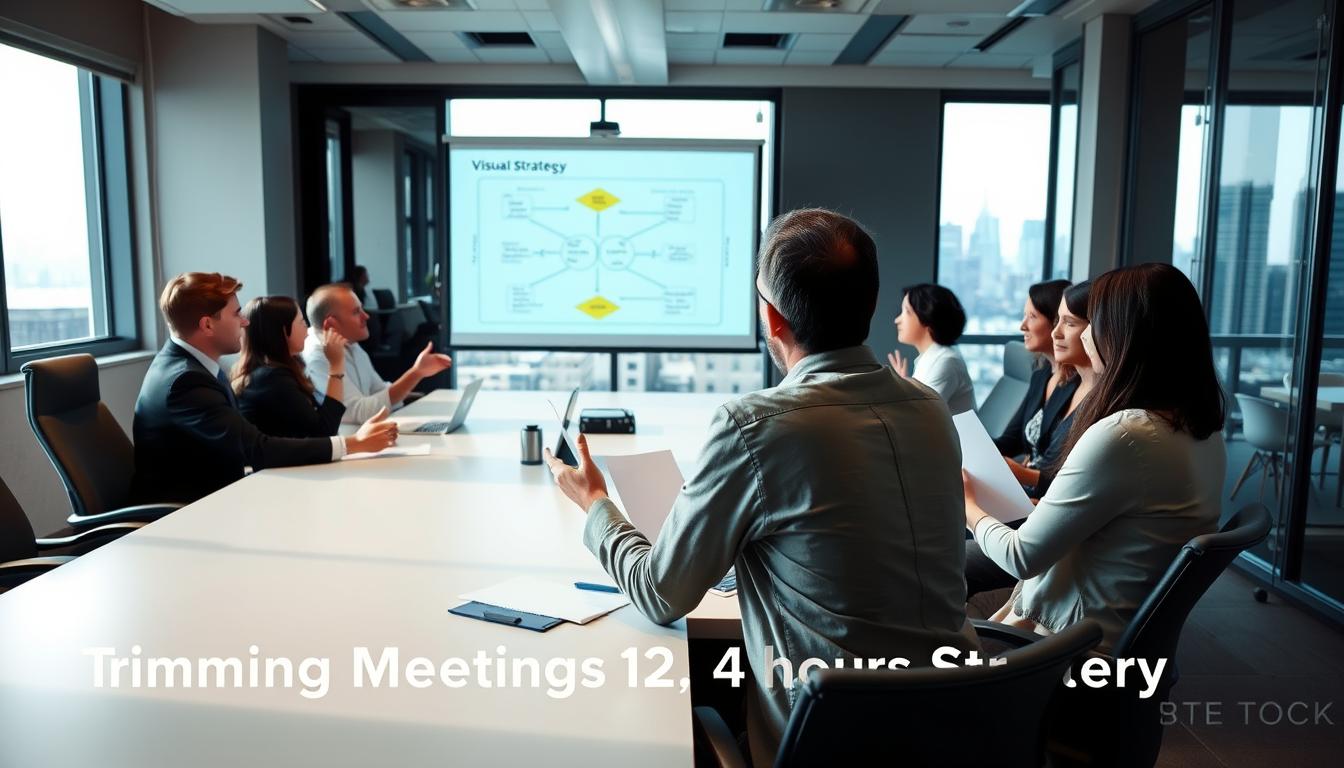In today’s fast-paced work world, teams find it hard to stay productive with so many meetings. The average worker struggles to manage time when too many meetings take away from important work. Many organizations saw this as a big problem. They started to look closely at their schedules. By cutting out meetings that weren’t needed every week, companies are making a big change. They are creating a work culture that puts value on focused work time. This shift is helping teams do better work.
The Impact of Meetings on Productivity
Meetings are key in today’s work environment, but people often argue about their value. A lot of data shows a worrying trend: many meetings are seen as a waste of time. This leaves employees feeling unhappy and questioning if meetings help at all.
Statistics on Meeting Overload
About 55 million meetings happen daily in different places. Shockingly, almost half are seen as a waste. Surveys show workers think only half of their meetings are useful. This shows a big gap: organizers think their meetings are great, but attendees don’t agree.
Common Perceptions of Meeting Effectiveness
Many workers say switching tasks in meetings makes it hard to get things done. This can make productivity drop, leading to burnout across the organization. The different views on whether meetings are helpful show we need to think again about how we use them in teams.
Identifying Unnecessary Meetings
In the business world today, it’s key to know which meetings matter and which don’t. Many workers are swamped with meetings that just waste time and don’t help. We’ll look at how to cut out useless meetings and check if the remaining ones are needed.
Recognizing the ‘Corporate Fluff’
Meetings with no clear goal or results are often just fluff. To spot these, teams should consider:
- Does the meeting have a defined purpose?
- Who really needs to be there?
- Can updates be sent by email or reports instead?
Identifying such meetings helps teams focus on what truly matters, boosting work and involvement.
Evaluating Meeting Necessity
Once you remove the unneeded meetings, it’s crucial to look at the remaining ones. Checking if a meeting is valuable includes:
- Looking at the agenda to see if it’s meaningful and to the point.
- Getting feedback on if they’re useful.
- Letting members skip meetings that aren’t vital.
This way, only important meetings happen, letting teams focus on big projects and new ideas.
What Happens When You Remove All Recurring Meetings for a Week?
Getting rid of meetings is becoming popular as teams look for ways to work smarter. Many stories show how stopping meetings for a week makes a big difference. Teams have found they get more done by focusing on what really matters instead of sitting in meetings.
Case Studies and Examples
Some groups tried removing meetings to see what would happen. For example:
- One tech company saw its developers work through their backlog 30% quicker without meetings.
- A marketing group got better at working together because they had undisturbed time to think creatively.
- Cutting out weekly updates let a finance team improve their reports’ accuracy through more concentrated efforts.
Potential Short-Term Gains
These stories point to positive changes right away, as people use their extra time to do better work. They reported big improvements in:
- How fast projects were done, leading to faster service delivery.
- Their happiness and satisfaction at work because they weren’t tired from too many meetings.
- Being more creative, as they had the chance to think of new ideas without interruptions.
Strategies for Reducing Meeting Frequency
Effective meeting strategies can really cut down on meeting time. This lets teams focus more on what they need to do. By combining meetings that are alike and using other ways to talk, companies can do more with less interruption. Here are some smart ways to make that happen.
Consolidating Similar Meetings
Teams often find themselves in too many meetings about the same things. Bringing these discussions into one meeting can make things run smoother. To do this effectively:
- Look for meetings that happen often and talk about the same projects or goals.
- Plan one big meeting where everyone involved can get together.
- Make a clear plan for the meeting that covers all important topics. This keeps things on track.
Transitioning to Asynchronous Communication
Moving to tools like emails or online project boards is a fresh way to work together. This lets people reply when it’s best for them. That can make conversations more meaningful and informed. The upsides include:
- Spending less time in live meetings means more time for actual work.
- Writing things down helps keep track of ideas and decisions better.
- People can look at messages when they can and think more about their responses. This helps everyone understand better.
Understanding the Value of Focus Time
In our fast-moving work world, the importance of focus time stands out. It’s key for boosting productivity and sparking creativity. When people dive deep into their tasks without interruptions, companies reach new heights of success.
Benefits of Extended Focus Periods
Long stretches of focus offer big wins for workplaces. They lead to:
- Increased efficiency in task completion
- Improved quality of work due to deeper engagement
- Better retention of information and knowledge
Those who get to focus without breaks tend to feel more satisfied with their work. They feel less buried under their to-do lists. This happiness boosts the company’s overall productivity.
Science Behind Focus Time and Creativity
Studies tell us that having time to focus can make us more creative and better at solving problems. The brain makes new connections and comes up with fresh ideas during these times. This not only enhances individual creativity but also improves teamwork.
To get the most out of focus time, companies should encourage it. They should set specific times for deep work and limit interruptions. This lets employees tap into their best creative selves.
Managing Gap Time Wisely
Those short moments between tasks, known as gap time, can boost your productivity. Knowing these moments lets you plan better and work smarter. By using gap time for helpful activities, you can work more efficiently and feel less stressed.

Maximizing Productivity in Short Blocks
Short time blocks are great for tasks that don’t need much focus. It’s crucial to pick tasks you can finish quickly. Here are a few productive tasks to consider:
- Prepare notes for upcoming meetings or calls.
- Reply to important emails or messages that demand quick attention.
- Organize your workspace and review your to-do list.
Methods for Effective Task Prioritization
To get the most from gap time, a good priority system is key. Break big projects into smaller tasks to easily finish them in these short periods. Here are some strategies to help:
- Assess tasks based on urgency and importance.
- Utilize task management apps to keep track of tasks.
- Set clear goals for each gap time to stay focused.
This organized way of using gap time improves productivity. It helps teams keep moving forward all day.
Challenges of Remote Meetings
Remote meetings come with their own set of challenges. They can make it hard for people to stay engaged. This is because virtual settings struggle to encourage active participation.
Attendees might get distracted by their surroundings. Also, not feeling accountable can lead people to pay less attention. This makes discussions less lively.
It’s important to tackle these issues for better virtual meetings. Having a planned agenda and encouraging active participation helps a lot. Clearly defining each meeting’s goals keeps discussions on track.
Asking everyone to turn their video on can make it feel more like a real meeting. This helps build a stronger connection among team members.
Differences Between In-Person and Virtual Interactions
In-person meetings allow us to pick up on body language. This makes communication more effective. But, remote meetings lack these cues.
This can make it tough to fully understand how engaged someone is. Without seeing their reactions, it’s hard to know if they are contributing or just distracted.
Best Practices for Remote Meeting Engagement
- Promote active participation through video conferencing to foster a sense of connection.
- Utilize chat features to encourage contributions from those who may hesitate to speak up.
- Designate a facilitator to guide the discussion and keep participants engaged.
- Incorporate interactive elements, such as polls and Q&A sessions, to maintain interest.
Adopting these strategies can make remote meetings more effective. They help overcome the usual problems of virtual setups. By working together, we can make remote meetings more engaging and productive.
Future of Workplace Meetings
The future of workplace meetings is changing as organizations find new ways to work together. There’s a big shift happening where meetings will be more intentional and flexible. Companies are starting to think hard about if a meeting is really needed and how it can best serve everyone’s time and work.
Shifting Organizational Culture
Today, as companies deal with new digital challenges, how we meet is also changing. Organizations are creating spaces for employees to share what they think about meeting styles. This way, they can make sure meetings fit what everyone needs, making people happier and more involved at work.
Innovations in Collaboration Tools
New tools are changing the game for workplace meetings. We’re seeing platforms that make it easy to mix in-person and online chats. These tools help teams stay connected, no matter where they are. They improve how we talk to each other and give us more time to focus on our own. Companies using these technologies will come up with new, better ways to meet and build a strong workplace culture.
Conclusion
Discussing how to make meetings better shows it’s very important for making work better. By changing how often we meet and what meetings are like, companies make a better work environment. This lets workers do their main jobs well, without too many meetings getting in the way.
Having fewer meetings each week has many good points. It makes a place where people respect time and this sparks new ideas. Teams can do great things. Making meetings fewer and using email or chats instead can change how we work. It makes things move faster and smoother.
It’s key for companies to always look at their meeting habits. Moving towards meetings that truly matter helps a lot. It means every meeting makes work better. This change helps workers do amazing things and achieve great results.



